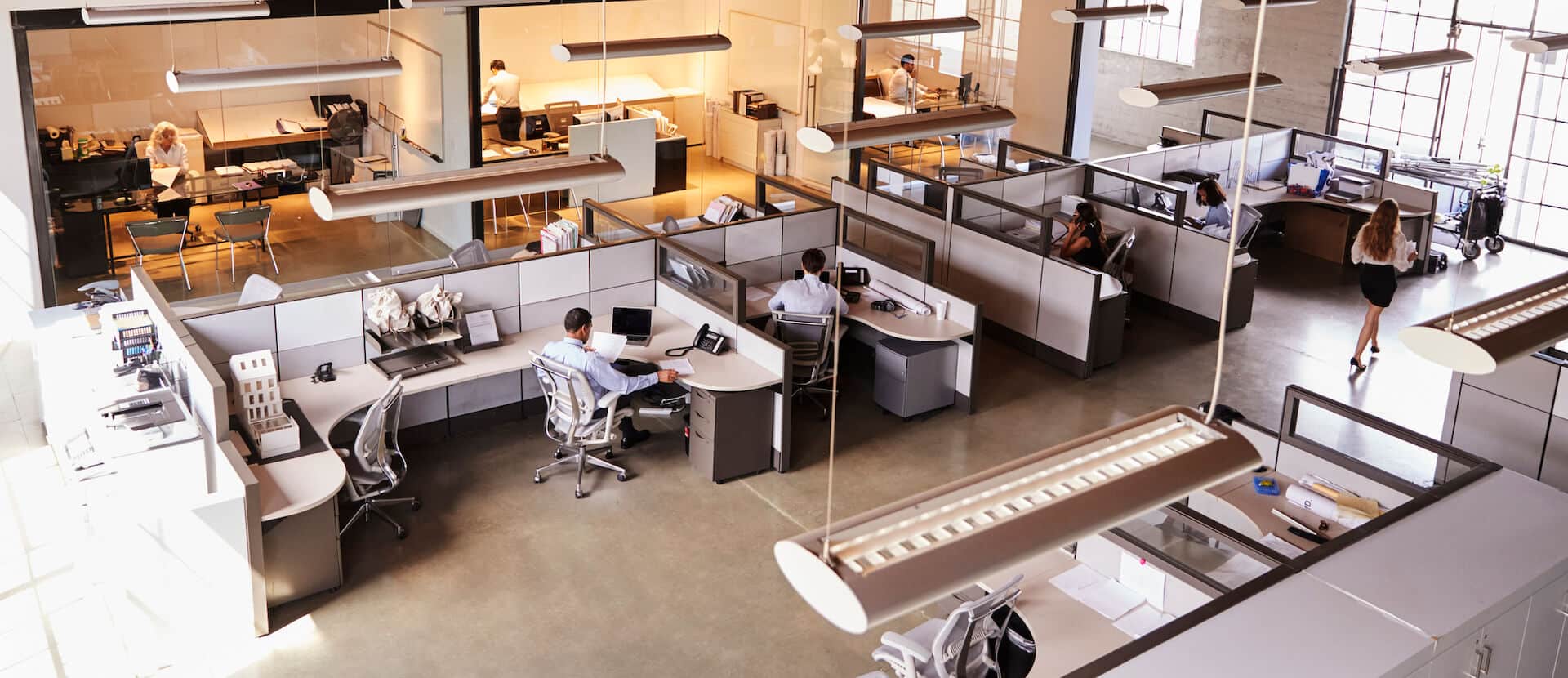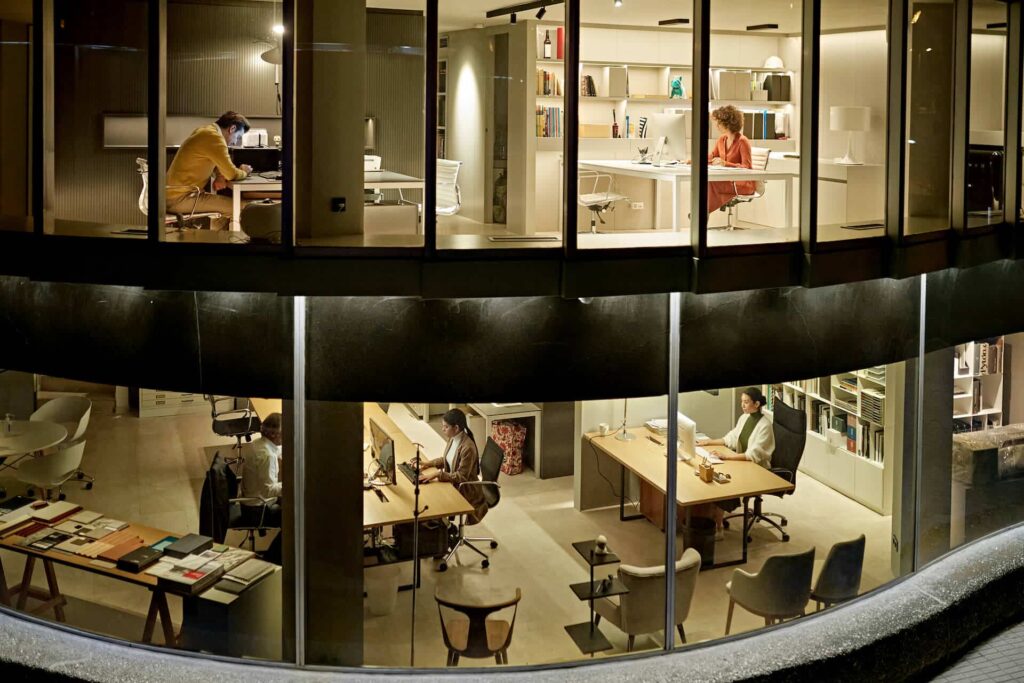Space optimization: benefits and best practices to streamline your workplace
By Patrick Holloway• 8 mins read•August 25, 2022

Good space optimization is often the key to real estate savings, employee productivity, and a great workplace experience. Of course, this process is dramatically more complicated when managing hybrid employees and/or a distributed workforce. So it’s no surprise that companies are actively looking for optimal solutions to improve how they’re using their space.
In this article, we explore the ins and outs of space optimization. While we’re focusing on how to optimize space use in a hybrid office environment, we cover best practices that will help optimize many types of space, including traditional offices.
What is office space optimization?
In general, space optimization is about finding ways to improve how you’re using a given space. Usually with the goal of cutting back on real estate costs.
In an office setting, this process can be quite granular, as facility managers (FMs) and administrators work to optimize floor plans and maximize different space types.
For example, does each business unit have the space they need? Do you have the right balance of formal and informal meeting spaces? Is your neighborhood layout actually in line with your neighborhood strategy?
Being able to answer these questions can dramatically improve decision making when it comes to space use.
And if you can reduce the amount of floors you need, you can then sell or lease them, or cut back on your real estate portfolio in general.
Reducing your footprint in this way leads to cost savings, of course, while also improving your environmental sustainability.
That said, while the objective function here is optimizing space, it can’t be done at the expense of employees. Employees need enough space (and enough of the right space) to be productive, engaged, healthy, and happy.
That’s why office space optimization needs to be carefully planned, using real estate analytics, workplace analytics, and, critically, employee input.
Only by using the right data and keeping the end users (i.e.: the employees) in mind, can companies create a flexible work environment that is affordable and fit for purpose.
In the past, this process was often done manually, with bloated Excel spreadsheets and lots of ‘guestimation.’
Today, FMs can use space management software to fully automate and improve this process.
What is the difference between space optimization and space utilization?
Understanding and improving your space utilization can lead to more space optimization, but the terms aren’t synonymous.
Like we’ve covered, space optimization is about creating a space that serves its purposes in the most efficient and affordable way possible.
Space utilization, on the other hand, is simply the measure of how space is actually being used in real time.
Understanding space use in an office setting
Office space optimization is one piece of a much bigger space planning puzzle.
In order to optimize their space, FMs and decision makers will need to have a solid grasp of the three basic elements of space management. These are: space planning, implementation using the right tools, and space tracking.
They should also be familiar with space management best practices and how to implement them.
Beyond this, space planners need to combine the following concepts carefully into order to create the right office ecosystem:
- Desk utilization, a more granular level of data that focuses on desks, not just rooms
- Room capacity, which refers to how many people can use the available space, often measured in people per square foot
- Office density, a measure of how many people are using a given space
- Occupancy rate, which measures how much space you’re actually using (i.e.: your office density), over a given period of time
- Headcount planning, which is the process that businesses use to anticipate future staffing needs and plan for their workforce of the future
When combined, these metrics can all be leveraged to help make more informed decisions. This leads to more strategic space management in the workplace.
From Fortune 100 space planning to improving the layout of small offices and startups, FMs should use the right software and the right methodology to get it right.

What are the benefits of space optimization?
Different companies will have different goals when it comes to optimizing their space. That said, optimum office space use generally brings the following five benefits.
1. Cost savings
Like we’ve covered, one of the biggest goals of data informed corporate real estate optimization is usually cost savings. Combining facilities or floors can help companies to minimize lease and/or ownership expenses.
Of course, using less space also reduces energy costs and other utilities. This is in addition to insurance, supply chain, and maintenance costs.
2. Workplace agility
When workplaces use their space well, they’re better able to quickly pivot as necessary, even when organizational priorities shift.
With this better operational efficiency comes better (and easier) workplace management, helping to overcome any space management challenges that arise.
3. Growth opportunities
A company with optimized space and workplace agility is a company that is ready for growth.
Armed with good workplace reports and analytics, FMs can make better plans for their workspace that minimize disruptions while maximizing productivity.
4. Improved employee experience
When an office space has too much or too little space, it’s often the workers who suffer.
And when workers suffer, so does innovation and collaboration in the workplace.
On the flip side, creating an office that is fit for purpose can lead to happier workers and more workplace wellbeing. This, in turn, can help with both talent retention and talent attraction.
5. A modern workplace
Finally, as we work to optimize hybrid work in our ‘new normal,’ companies are experimenting with a variety of new work environment types.
Whether it’s agile working, free addressing, flexible seating, working neighborhoods, or anything in between, having a well-optimized, modern office floor plan is often the first step towards improving both the hybrid workplace and the employee experience.
“It’s not fit for purpose, down to the team level and down to the individual, you could be misappropriating funds, resources, space, and technology.”
Angie Earlywine, Senior Director in the Total Workplace division of Global Occupier Services, Cushman & Wakefield

Space optimization best practices
Getting space optimization right in an office setting is a bit like Goldilocks and the three bears. You don’t want an office that is too big or too small.
“It’s not fit for purpose, down to the team level and down to the individual, you could be misappropriating funds, resources, space, and technology,” says workplace strategist Angie Earlywine, Senior Director in the Total Workplace division of Global Occupier Services at Cushman & Wakefield.
Every organization will need a customized approach to office space optimization. But there are certainly some best practices to follow.
The importance of data
First, data is essential.
The more real-time insight you have into how people are actually interacting with and using your space, the better position you’ll be in to make any changes.
This can help you establish a baseline occupancy. Then, you can gain a good understanding of the minimum number of people who are typically in the office.
Ideally, your data will pull data from desk booking and room booking software. This will give you accurate, actionable information around how people are using the office. Note that IoT sensors and a badge system can provide even more meaningful insight.
For example, you might be able to determine whether you need more quiet booths or huddle rooms. Or if people are mainly coming into the office for collaboration versus heads-down work.
Armed with this data, you can then adjust your space accordingly.
Employee feedback
Second, and just as important, you should solicit employee feedback before making any drastic changes to your physical space.
“It’s best to conduct employee surveys and focus groups regularly, and then adjust based on that feedback,” says Earlywine. “If I reduce real estate because I don’t think we need as much, all of that is a potential risk with significant costs associated. The antidote to figuring out how to reduce risk is in ensuring you’re aligned with employee sentiment and the company’s vision for supporting a hybrid work environment.”
The best hybrid work model
Third, companies need to develop a hybrid work model that suits their goals and culture.
This will be an iterative process, since hybrid work is new and rapidly changing.
‘It’s really important to stay agile as we figure out what flexibility means and test different methodologies and configurations,” says OfficeSpace Software CEO David Cocchiara. “You need to measure how space is being used and the general sentiment for the space, to figure out the best space going forward.”
Part of this process will be creating clear guidelines around remote and hybrid work, in order to glean insights into exactly how many people are actually coming into the office (versus how many want to come into the office).
Many companies are now also working to create a more appealing physical space, in order to encourage more people to want to use it.
Finally, beyond these best practices, space optimization works best when FMs and decision makers are equipped with the following tools.

Space optimization tools
Good space optimization starts with good data management, which in turn starts with the right workplace technology.
Ideally, the same integrated workplace management system (IWMS) that allows for desk and room bookings will also gather data about this usage and put it into meaningful reports.
It can also be part of a lease management system that helps you manage your leases and track important dates.
And better still if the IWMS also simplifies office scenario planning and stack planning, so that FMs can play around with any new ideas for better space utilization, before having to commit to anything on the ground.
Space optimization FAQs
How does space optimization save money?
Good office space optimization saves money in two key ways. First, if companies are able to reduce the amount of space they need, they can either sell or lease their leftover space, or they can reduce their own lease payments. Second, using less space also means using less energy, utilities, and other associated costs.
In the long term, good space optimization can also improve employee experience, which can have a positive impact on productivity and talent retention.
How does space optimization affect the environment?
The less space a company uses, the less energy and resources they use. In this way, good space optimization can dramatically reduce their overall carbon footprint. Space optimization may also lead to more remote and/or hybrid workers, which in turn can lead to fewer employees traveling to and from work each day, further reducing the environmental impact.
How does space optimization reduce office clutter?
Space optimization doesn’t inherently reduce office clutter, unless shared desks are part of the equation. Shared desks typically don’t collect personal items, so they tend to be clutter-free. This type of flexible seating is one of the most common ways to optimize space, as seen in many hybrid workplace examples.
How is space optimized in a small room or office?
Companies looking to optimize space in a small room may want to consider shared desks. Shared desks can reduce the amount of space they need overall. Strategies like office neighborhoods, agile working, and activity-based working can also make more efficient use of a small office space.
Of course, allowing employees to work remotely or on a hybrid work schedule can also reduce the amount of people needing to use a space at the same time. This can help companies maintain a small office space.
What is free space optimization?
Sometimes, offices have areas in the office that aren’t being actively used. Perhaps because of their layout or location, these spaces don’t work for desks or meeting rooms. Companies looking to optimize these free spaces often turn to flex room ideas like private phone booths, games rooms, or retreat rooms.
OfficeSpace offers all the necessary features to simplify and streamline space optimization in any sized office. Reach out for a free demo.
Photos: gece33, xavierarnau, Business, jeffbergen



